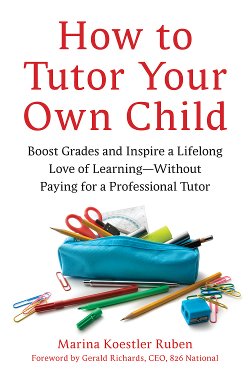My post on Friday dealt with the staggering size of the US private tuition industry, and the uneasy tension between the personalized learning experience (which many would understand to be at the heart of tutoring) and the increasing encroachment of big business into this field.
Therefore, as an antidote, I thought I would share with you a new book by the American tutor/ author Marina Koestler Ruben entitled How to Tutor Your Own Child: Boost Grades and Inspire a Lifelong Love of Learning – Without Paying for a Professional Tutor (see above). The basic premise is that parents can be just as good when it comes to coaching their children, thus echoing some of the research I pointed to in an earlier post, Tutoring: A Tool for the Masses?.
Judging from some of the internet buzz already surrounding this book, it looks like a valuable (and entertaining) resource. The positive comments on the US Amazon site don’t just include parents, but also teaching professionals. I get a sense it’s going to be a useful resource for many private tutors too. The Chicago Tribune has just published an interview with Ruben, in which she very briefly outlines the 6-step method at the core of her tutoring. Below is an extract from the article:
Q: I don’t know how to teach. How can I tutor?
A: Teaching and tutoring are different. A teacher presents material. A tutor checks to see if the child has understood. A big part of a tutor’s job is helping a child learn how to learn, to come up with techniques to retain and clarify information.
Q: What tips might I adopt from professional tutors?
A: Show your child you love learning. You want your child to take on that feeling. Be calm. If the child has delayed or procrastinated, respond calmly to help him come up with a plan. Break down big tasks.
Q: What if I don’t know the subject?
A: It depends on the kind of help your child needs. Ask to see his notes to refresh your memory. Talk yourself through them as he observes. Prompt him to explain them. Sometimes just reviewing his notes, which students may overlook as a means of studying, will be enough for him to grasp the concept.
If it’s something like a specific math problem, it’s appropriate to seek outside help. Help your child find the proper resource. Walk him back through his notes, or guide him to similar problems in his textbook. Direct him to write the problem to ask a teacher, look it up online, or contact a student who succeeded in the class. Parents can contact a college or graduate student if it’s high-level math or science. It’s still cheaper than hiring a pro.
Q: I’ve got the basics to tutor: a large surface with equal access for me and my child, and the supplies. Now what?
A: A formal session follows six steps. 1. Give your child your undivided attention. 2. Open the session with an encouraging statement. 3. Ask what’s new in the subject since you last met. 4. Ask what’s happening now in his class. That’s your work for this session. 5. Ask what’s next, to plan for upcoming assignments or exams. 6. End on a positive note. You want your child to leave feeling empowered.
The author Marina Ruben’s own blog is here.


Warning: Declaration of Social_Walker_Comment::start_lvl(&$output, $depth, $args) should be compatible with Walker_Comment::start_lvl(&$output, $depth = 0, $args = Array) in /var/www/vhosts/thetutorblog.com/httpdocs/wp-content/plugins/social/lib/social/walker/comment.php on line 18
Warning: Declaration of Social_Walker_Comment::end_lvl(&$output, $depth, $args) should be compatible with Walker_Comment::end_lvl(&$output, $depth = 0, $args = Array) in /var/www/vhosts/thetutorblog.com/httpdocs/wp-content/plugins/social/lib/social/walker/comment.php on line 42
Very interesting Article, and I think I will have to check out the book. In my many years of experience, the best tutors are always ex-teacher – agreed they are different skills in some ways, but the ability to understand an individual’s learning style and capability,and getting the most out them to really educate is something that usually only comes with time and experience.
Thanks
Si
Home Tutoring Solutions|Home Tutoring|Maths Tutoring…
[…]Parents: You Can Tutor Too | The Tutor Blog[…]…